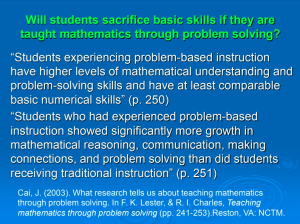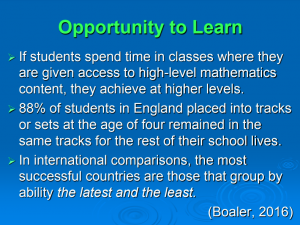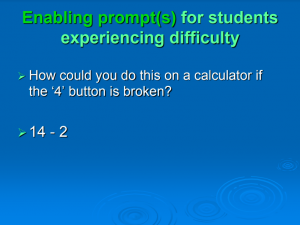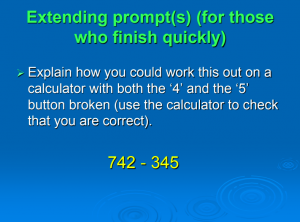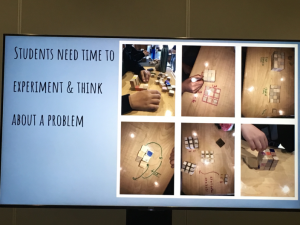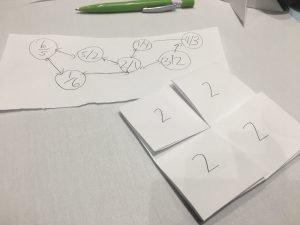This blog is the second of two reflections on the annual MANSW (Mathematical Association of NSW) conference “Mathematics: The greatest Show”, you can access the first blog here. Following on from the first blog, this reflection focuses on the keynote and a couple of workshops from Day 2 of the conference.
Choosing and using problems and pedagogies which build challenge
Doug Clarke presented the Day 2 Keynote. I’ve heard Doug many times before and every time I learn something new. Doug has a way of talking about mathematics teaching strategies that makes me nod my head, internally saying “yes, this makes so much sense, why have I not been doing this already!” Or sharing what at face value seem to be the simplest of activities that he then builds, and builds upon, turning them into deep learning investigations that could go on forever in the classroom.
“There are 200 fish in a pond, 99% of the fish as guppies, how many guppies would we need to take out so there are only 98% guppies?”
Doug posed the above problem to get everyone thinking as he started the keynote. I’ll just leave it there for you to ponder as well! His focus was on the importance of challenge and ensuring students have a toolkit for problem solving. He quoted Matt Skoss (@matt_skoss) regarding the tool kit saying that Matt talks about the tool kit including the proficiencies (understanding, fluency, problem solving and reasoning), not just the content of mathematics. The proficiencies are at least as important as the content, if not more.
In the past there has been debate about whether students sacrifice basic skills if they are taught mathematics through problem solving. Doug discussed the research surrounding teaching through problem solving and that students often show more growth on standard testing if they have experienced problem-based instruction. Doug also noted that in real life, as adults, over a third of calculations only require an estimation (time and money concepts). Knowing basic skills doesn’t always equate to students being able to estimate and work out reasonable approximate solutions, this comes through problem solving thinking.
As well as talking about the importance and value of teaching through problem solving, Doug also talked about the importance of the opportunities to learn that we provide (or remove) from our students based on how our classes are arranged. Quoting Jo Boaler’s (@joboaler) research, Doug highlighted the often negative effects that ability grouping can have on students, particularly in the early years where 88% of students who were ability grouped at a young age, remained in those groupings for the rest of their lives. I would image this statistic may also be true in Australian schools where ability groups are still common. What types of mindsets are these creating in our young students? Where is the room for growth and flexibility?
“Countries that group by ability latest and the least succeed the most.”
Doug shared a number of open-ended tasks to use in the classroom that encourage problem solving and reasoning. Using enabling and extending prompts are an important structure to lessons where the ways of solving the task or the solutions to the task are open and varied. Doug mentioned Peter Sullivan’s great book that is a great starting place for teachers who haven’t used open-tasks or enabling or extending prompts before. I highly recommend purchasing this book (along with Doug and Ann Roche’s book 25 Favourite Lessons and Doug’s other book about Rich Tasks and Work Samples that he wrote with Downton, Knight and Lewis).
Some other great advice Doug gave was regarding engaging students through finding opportunities for them to choose something that interests them and do mathematics at the same time. In research that Doug’s brother David Clarke conducted on the learner’s perspective, students were asked What was the event in the lesson from which you learned the most? Out of the 14 countries this question was asked in, the most common response in 13 out of the 14 countries was “something another student said”. As teachers, our role is important, but we often overlook the power of other students and them learning from and by each other.
Teaching strategies such as using Low floor, High ceiling tasks were also mentioned. As was discussion starters like Same or Different? questions (check out Matt Sexton and Jill Brown‘s research on concept cartoons as well). These provide opportunities for students to think, share and gain knowledge from their peers. It links to students’ prior knowledge and provides moments to find and discuss any misconceptions students have. The use of conjecture – promoting predictions that can be agreed, or disagreed with, also increases student talk and learning. This is also a time for us as teachers to ‘hold back’ just watch and listen and only intervene when necessary. Doug talked about “teacher lust”, the desire that teachers often have to ‘tell’ students things they could work out for themselves, a practice we need to avoid.
@MattSextonACU you and Jill got a good mention today too! I really like what you are doing and how it could link it well with T planning for possible St strategies and Talk Moves. pic.twitter.com/MUkQawtxvM
— katherin cartwright (@kath_cartwright) September 21, 2019
Enhancing creativity in mathematics through critical thinking
I attended a workshop session during Day 2 led by Kirsty Thorpe. Kirsty was the MANSW Scholarship Study tour winner from 2018, she shared her experiences from visiting schools in Singapore, Cambodia and the US. Her focus was looking for ways to enhance creativity through problem solving in primary mathematics. From her own teaching experience in Sydney, she felt that many of her students ‘knew the maths’ but were lacking risk taking and perseverance when it came to problem solving. Some of the take-away messages Kirsty shared were:
- embracing “new pedagogies deep learning” to build character in students and prepare them to be global citizens (Michael Fullan)
- seeing the importance of play and equity “for every hour of school, 15 minutes of play” (Pasi Sahlberg talking about Finland)
- teaching teachers how to teach mathematics more openly
- mathematical mindsets and changing students’ dispositions towards mathematics (Jo Boaler, “What’s maths got to do with it” book)
- noting shifts in what high-performing countries are focusing on eg Singapore, no streaming, no standardised testing – more focus on differentiation
Kirsty talked about how she had brought back many of these ideas and thoughts on mathematics pedagogy and was implementing them in her own classroom. She also highlighted that her school were part of the EPMC (Encouraging Persistence, Maintaining Challenge) project (you can read a bit about the project here) and were using Peter Sullivan’s enabling and extending prompts in their classrooms. Kirsty talked about allowing her students to have a chance to explain and this built confidence as they shared their thinking with others. She explored tasks over a number of days, continuing the conversation and the lesson when students needed more time. She mentioned ‘slow teaching’ which I have written about in a previous blog.
Maths in paper folding
@standupmaths you asked for it... The bottom right half of the square's perim = the bottom right half of the kite's perim, iff a=b+c. c is the same length as the other two segments marked with ', so it's true. #manswgreatestshow pic.twitter.com/wvtNrteOOs
— Anita Ponsaing (@poncita) September 24, 2019
In the afternoon I had a great time discovering the maths of paper folding with Matt Parker. His session was highly engaging, hands-on and explored the mathematical concepts of geometry with paper. I love playing with geometry in a concrete way and finding ways to justify thinking by doing, not just because we know the formula. I was sitting with a mix of primary and secondary teachers which was so much fun. I loved how they ‘knew the math’ for many of the tasks and it made me determined to prove it without numbers, as for primary students who haven’t been exposed to square roots yet, it’s important that there are many ways to show how something works and why! You can have a go at one of the tasks via this Twitter post by Matt.
Well I hope you enjoyed reading part two of my reflections from the annual MANSW conference. As I mentioned in the first one, you can also check out other people’s posts and comments via the twitter hashtag #manswgreatestshow and also watch the MANSW conference page so you can register early for the 2020 conference. It will be awesome and will sell out fast! MANSW Annual conference 18-20 September, 2020 at the Novotel Wollongong “A Maths Odyssey: Space … and geometry” with keynote speaker Dan Finkel @MathforLove.
